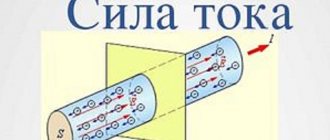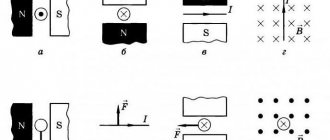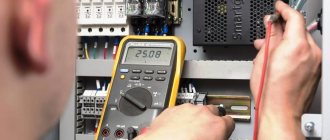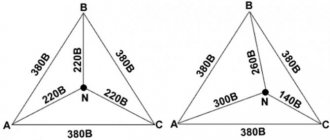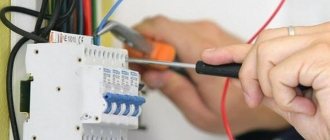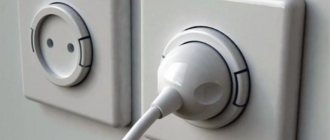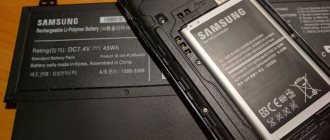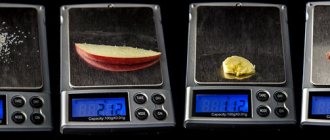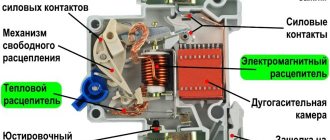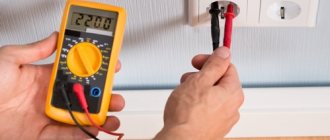Machine capacity and power indicator
In response to the question, 16 amperes are how many kilowatts, it is worth pointing out that such a circuit breaker can withstand a load of 3.5 kW in a single-phase network and 18.2 kW in a three-phase network. A 32A device is 7 and 36.5 kW, a 40A device is 8.8 and 45.6 kW, a 63A device is 13.9 and 71.8 kW, respectively. In this case, the supply voltage in the outlet in the first case should be no more than 220 volts, and in the second case - no more than 380 volts.
Power or load force is the amount of energy consumed by all electrical appliances that are connected to the same line. To calculate this number, you need to take the current load and select a higher current rating or equal to the resulting value.
Note! The power of the device 16A is 3520 W, 32A - 7040 W, 40A - 8800 W, 63A - 13860 W in a single-phase circuit. The power of the device 16A is 6080 W, 32A - 12160 W, 40A - 15200 W, 63A - 23940 W in a three-phase circuit. The conversion to kilowatts is presented above.
General characteristics
The device has 2 types of releases built into it. Thermal reacts to heating of the cable. Therefore, in hot weather the operation may be false. For different overloads, automatic shutdown takes the following amount of time (in Amperes):
- 18.08 - in an hour;
- 23.2 - within a few minutes;
- 40.8 - up to 60 seconds.
Automatic C16 Electromagnetic release is designed to turn off the automatic circuit breaker during limit values during a short circuit. The error for household appliances can be plus/minus 33%. The response to the various limits can be as follows (in Amperes):
- 80 - more than 0.1 second;
- 160 - in less than 0.1 second;
- 4500 - may remain suitable for further use after shutdown;
- 6000 - fails, and there is a risk that it will not work due to melted contacts.
Reaction to a strong short circuit The capacity of a single-pole device and with a large number of poles is 16 A, that is, the power is 3520-3680 Watts (for a network of 220-230 Volts). If the current strength is equal or lower, the machine will not turn off at a positive temperature of 30 degrees Celsius.
The machine body is not protected from direct water ingress. Therefore, it can be installed in a heated and ventilated room or in a sealed enclosure. The rear wall is made with a groove for mounting the device on a 35 mm wide DIN rail.
Characteristics of a 16 amp machine
It is marked on its body with rated current, switching capacity, current limiting class, rated breaking capacity and time-current response characteristics of the switching system. The rated current value is 16 amperes, which can be lowered or increased when the temperature changes in the appropriate direction. The switching capacity is 4500 and 6000 amperes for a household unit, and the current limit is 10 milliseconds.
GOST and standards
For example, compliance with a standard. Here is a model from Schneider Electric that simultaneously meets two international standards.
These standards have domestic analogues. For the Russian market, GOST R50345 is most often indicated.
This inscription means that the switch can only be used in domestic conditions.
It can be serviced by ordinary consumers and individuals without undergoing any training or instruction.
There is another GOST R500030.2
These models are already designed for use in industrial environments. Only qualified personnel are allowed to work with such devices.
Further, some inscriptions may duplicate information on the front panel.
U=400V – rated operating voltage
Icn=6000A – highest breaking capacity
50/60Hz – power supply frequency
I=8In (C) – the circuit breaker has a “C” characteristic with an electromagnetic shutdown limit of 8 times the rated current (+-20%).
Purpose
A 25 ampere circuit breaker is a device whose main task is to ensure the safety of the electrical network from overcurrent, that is, from a short circuit with overload. The main purpose of the device is to ensure the safety of the user himself when using the network and electrical appliances.
Such equipment is turned on and off from an electrical circuit. It is most often used to protect an electric stove or other kitchen heating appliances.
Note! It can also be used to protect lighting system, motor, transformer and electronic appliance.
Operating principle
The main element of the device is an electromagnetic and thermal release. The first guarantees protection against short circuits, the second - against overvoltage. An electromagnetic device is a coil with a core, which is placed on a special spring and, under normal conditions, creates an electromagnetic field that attracts the coil core. At the moment of a short circuit, the electric current increases and exceeds that nominally stated according to the technical characteristics. This current flows through the release coil and increases the field. As a result, the circuit is de-energized.
A circuit breaker is a device that ensures that all electrical equipment in the house and on the network operates properly. To calculate how many kilowatts a machine can withstand at 16, 32, 40 and 63 amperes, as well as see their power, just use the table above.
It is impossible to imagine the modern world without electricity. Every home has a variety of appliances, and people sometimes don’t even think about how much power all the devices and devices connected to the power grid consume.
Household appliances have become so integral to people's lives that as soon as a device breaks down, a person begins to get nervous, and some even panic.
Since there are usually many different devices operating in an apartment or house, the uninterrupted operation of a computer, refrigerator or TV and other devices often leads to exceeding the permissible standards in electrical networks, and as a result, a short circuit occurs.
Time-current characteristic (VTC)
Using this graphical display, you can get a visual representation of the conditions under which the circuit power-off mechanism will be activated (see Fig. 2). On the graph, the time required to activate the AB is displayed as a vertical scale. The horizontal scale shows the I/In ratio.
Rice. 2. Graphic display of time and current characteristics of the most common types of machines
The permissible excess of the standard current determines the type of time-current characteristics for releases in devices that perform automatic shutdown. In accordance with current regulations (GOST P 50345-99), each type is assigned a specific designation (from Latin letters). The permissible excess is determined by the coefficient k=I/In; for each type, the values established by the standard are provided (see Fig. 3):
- “A” – maximum – three times excess;
- “B” – from 3 to 5;
- “C” – 5-10 times more than standard;
- “D” – 10-20 times excess;
- “K” – from 8 to 14;
- “Z” – 2-4 more than standard.
Figure 3. Basic activation parameters for various types Note that this graph fully describes the activation conditions of the solenoid and thermoelement (see Fig. 4).
Displaying the operating zones of the solenoid and thermoelement on the graph
List of typical time-current characteristics.
Having decided on the labeling, let's move on to considering the various types of devices that meet a certain class depending on the characteristics.
Table of time current characteristics of circuit breakers
This type is installed in circuits not subject to short-term overloads. As an example, we can cite circuits based on semiconductor elements, when they fail, the excess current is insignificant. This type is not used in everyday life.
Characteristic "B"
The difference between this type and the previous one is the operating current; it can exceed the standard one from three to five times. In this case, the solenoid mechanism is guaranteed to be activated at a five-fold load (de-energization time - 0.015 seconds), the thermoelement - three times (it will take no more than 4-5 seconds to turn off).
These types of devices have found application in networks that are not characterized by high inrush currents, for example, lighting circuits.
S201 from ABB with time-current characteristic B
Characteristic "C"
This is the most common type, its permissible overload is higher than that of the two previous types. When the normal operating mode is exceeded five times, the thermocouple is triggered; this is a circuit that turns off the power supply within one and a half seconds. The solenoid mechanism is activated when the overload exceeds the norm by ten times.
These AVs are designed to protect an electrical circuit in which a moderate inrush current may occur, which is typical for a household network, which is characterized by a mixed load. When buying a device for your home, it is recommended to choose this type.
Legrand three-pole circuit breaker
Characteristic "D"
Such devices are used in circuits with high inrush currents. For example, to protect starting devices of asynchronous electric motors. Figure 9 shows two devices in this group (a and b).
Figure 9. a) VA51-35; b) BA57-35; c) BA88-35
Characteristic "K"
For such AVs, activation of the solenoid mechanism is possible when the current load is 8 times higher, and is guaranteed to occur when there is a twelve-fold overload of the normal mode (eighteen-fold for constant voltage). Load disconnection time is no more than 0.02 seconds. As for the thermoelement, its activation is possible when it exceeds 1.05 from the standard mode.
Characteristic "Z"
This type is distinguished by a small permissible excess of the standard current, the minimum limit is two times the standard current, the maximum is four times. The thermoelement response parameters are the same as those of AB with characteristic K.
This subtype is used for connecting electronic devices.
Characteristics "MA"
A distinctive feature of this group is that a thermoelement is not used to disconnect the load. That is, the device only protects against short circuits, which is quite enough to connect an electric motor. Figure 9 shows such a device (c).
How machines are mistakenly chosen
In practice, they usually choose an automatic machine without much thought. Many are based on the required load, namely, they try to install such a machine so that it simply does not turn off under heavy load. So, for example, if 5 kW is required, then they install a 25 A automatic machine, if there is a 3 kW load - a 16 amp automatic, and so on. But this approach is completely ill-considered, since it will only lead to equipment breakdown or, even worse, to an electrical fire or even a fire.
The circuit breaker was invented to protect against overload. This is a protection switching device, not an electrical panel decoration.
Operating principle of circuit breaker
The AB (circuit breaker) is designed to protect from overload all devices connected in the electrical circuit directly after it.
If it is chosen incorrectly, it will not work properly. So, for example, if you use an electric cable that is designed for 4-5 amperes and run 20-30 amperes through it, then such a machine will not turn off immediately, but will wait until the insulation melts and a short circuit occurs. Then it will turn off. But this is not what proper operation of the circuit breaker should lead to. Therefore, it is important to consider in advance, when installing a 16-amp machine, how many kW it will withstand in the presence of wires of a certain cross-section and maximum operating load.
Ideally, it should turn off as soon as it senses an overload. Then the wires will remain in order and the connected equipment will not burn out.
What is the conclusion?
Each of the machines has its own distinct advantages and disadvantages. Some are expensive, others are not as compact as the consumer would like. In any case, the choice of switch depends on the load supplied to the housing and the cross-section of the conductors.
Which one is suitable for a particular home will be indicated by the markings on the body of the product. It is better to entrust work related to electrical wiring to electricians, since despite innovations, no one has canceled the rule that everyone should mind their own business. The safety of all residents and the safety of property depends on properly connected electricity.
Electronics and technologyComment
Choosing the right machine
How can you understand how many kilowatts a 16-amp machine can withstand in practice?
The most common correct way to select a circuit breaker is:
- determine the wire cross-section
- according to the rules of electrical installations, find the current that is permissible for such a wire cross-section
- select the machine that suits these parameters
For example, there is a copper wire with a cross section of 1.5 sq. mm. The current allowed for it is a maximum of 18-19 amperes. Accordingly, according to the rules, you need to choose a suitable machine, but with a downward shift according to the table. And this turns out to be 16 amperes. That is, you can install a 16 amp machine.
If the wire is copper and its cross-section is 2.5 sq. mm, then only a current of up to 26-27 amperes is allowed. Therefore, the maximum you can use is a 25-amp machine. Although, for reasons of reliability, it is better to install a 20-amp machine.
In this way, the parameters of the required machine for the remaining wire sections are calculated.
Types of slot machines
When choosing a circuit breaker, it is very important to study all the characteristics of the device. It is also necessary to carefully calculate the total power of all devices that are supposed to be connected to each group of machines. Not only the speed of operation of the switch, but also the quality of its operation will depend on these factors.
Most often, both in everyday life and in production, 16A machines are found. They are usually installed in electrical panels. Therefore, the question of how much a 16-amp machine can withstand is always relevant.
Manufacturing companies
A modular machine from a foreign brand of a domestic series meets the standards required for machines in everyday life. But industrial ones are of better quality, more reliable and easier to install. The most famous of them:
- Russian – KEAZ, IEK, EKF.
- foreign - ABB, Schneider Electric, Legrand;
Modular devices from domestic companies are manufactured in China, although this is not a sign of their unreliability. The quality is somewhat worse than the domestic series of foreign manufacturers. They are cheaper. It also meets the standards for domestic cars. They usually do not have series similar to the production complexes of foreign companies.
Features of switches
Circuit breakers are made of materials that are completely harmless to human health. Self-extinguishing thermoplastic is used in the manufacture of the device body. It is able to withstand very high temperatures. Its contacts are made of copper plates, silver plated for better contact and durability.
The design of the circuit breaker contains a special thermal relay, which is activated when the current flow exceeds the norm, and the electrical circuit opens without causing a short circuit. The higher the current indicator, the faster the operation speed of the machine. The count goes on in fractions of a second.
The scope of use of automatic switches is very extensive and extends from their installation in incoming electrical panels to distribution boards of apartments or houses. To use circuit breakers, special distribution boards are produced with already installed DIN rails for the required number of circuit breakers. The buyer only needs to choose the one that meets his wishes and install the shield in the apartment or house.
Despite the apparent simplicity of using circuit breakers, it is better to entrust the connection of a 16-amp circuit breaker to a specialist.
In terms of rated current, circuit breakers differ both in current strength (rated from 1A to 6300A) and in the load on the circuit (220V, 380 and 400V). In addition, switches are usually distinguished by their response speed.
I once wrote about the wiring for the hob, that I was installing a new one, etc. Then I really screwed up with the cable - I didn’t expect that the induction cooker would consume 7.5 kW. And it cannot be plugged into a regular 16A (Ampere) outlet. Some time passed, and a guy wrote to me that he also installs a hob, and wants to connect it to a regular 16A outlet? The question was something like this: will the outlet withstand the voltage from the stove? And 16 A is how many kilowatts ? Just awful! I didn’t expose the guy, but such a connection could burn down your apartment! Be sure to read on...
Guys, if you don’t know what and how it’s calculated! If at school it was bad with physics, and especially with electricity! Then it’s better for you not to get involved in connecting electric stoves! Call someone who understands!
Now let's talk about voltage and current!
First, I’ll answer the question - 16A how many kilowatts (kW)?
Everything is very simple - the voltage in the home electrical network is 220V (Volts), to find out how much a 16A outlet can withstand - 220 X 16 = 3520 Watt, and as we know in 1 kW - 1000 W , it turns out - 3.52 kW
If the formula from school physics is P= I * U, where P (power), I (current), U (voltage)
In simple words, a 16A socket in a 220V circuit can withstand a maximum of 3.5 kW!
Induction hob and socket
An induction hob consumes 7.5 kW of energy with all 4 burners turned on. If you divide in reverse order, you get 7.5kW (7500W)/220V = 34.09A
As you can see, the 34A consumption will simply melt your 16A socket!
Well, okay, you think...
Then I’ll install a 32-40 A outlet and connect the stove! But that was not the case, you need to know what wire you have in the wall, and also what machine everything is connected to in the panel!
The thing is that the wires also have a maximum power threshold! So if you have a wire with a cross-section of 2.5 mm, then it can withstand only 5.9 kW!
Also, the machine should be set to 32A, or better yet, 40A. Once again I recommend this article! More details there!
So calculate correctly! Otherwise, your socket-wiring will melt from the high voltage and a fire could easily occur!
Alignment methods
Comb
Installation is easy. For the required number of machines, a specific comb model with the required number of poles is selected.
When choosing a comb with the maximum number of contacts, you should remove the excess using a hacksaw. To complete the installation, the tire is inserted into each clamp at the same time, and then the screws are tightened. The outputs are installed according to the diagrams.
Jumpers
Connecting machines using jumpers is used when there are a small number of switches and there is enough space in the panel for unhindered access to all contacts. This method can be used not only for a single-phase type of circuit, but also for a three-phase version.
For work carried out in the panel, it is worth preparing all jumpers of the required length, as well as the appropriate cross-section. For the so-called single-core conductors used, a cross-section is selected to combine the wires of the machines with a pre-calculated power. One of the suitable methods for creating jumpers is the continuous method.
At the end of such preparation, it is preferable to remove the existing insulation from the ends by about a centimeter, then expose the wire by removing the film with a knife.
Then you should install the ends into the entrance holes, while tightening the screws. Then the load sources are connected to the output, as in the photo, which clearly shows the connection of automatic switches.
Do not forget that it is important to not press the neutral and phase wires tightly because of their possibility of heating during operation of the electrical network, as well as the likelihood of unwanted alignment of the zero with the phase due to softening of the insulation under the influence of heating
To combine switches with a cable, you can use a stranded wire with the required cross-section
However, in this case it is important to clean it a few centimeters
A special tip corresponding in size to the cross-section of the wire used should be put on the end, crimped using pliers. You can combine switches in sequential order.
Following the instructions for combining switches located in the panel, but in the absence of the required tools, as well as tips, you can tin the uninsulated wire using a soldering iron.
READ Built-in electric ovens how to connect
Remember that the correct connection of machines with each other using a stranded conductor should be carried out by adhering to a previously developed diagram. In this case, you can use machines from different manufacturers. Their diameters can be completely different, since installation with a flexible type wire makes it possible to do this.
When deciding which wire is preferable to connect the machines, check the correctness of this connection. As a rule, this is common for a three-phase circuit. Even a tiny mistake can cause a short circuit and, consequently, damage to the electrical device you are using.
Source


